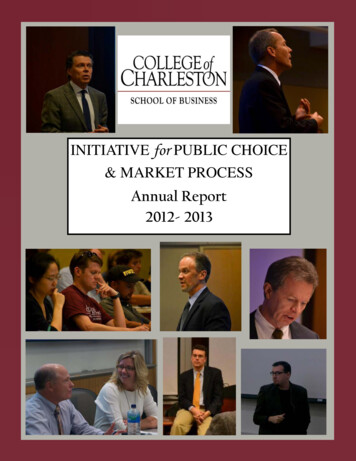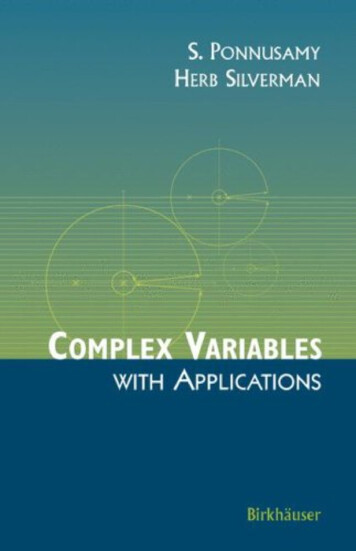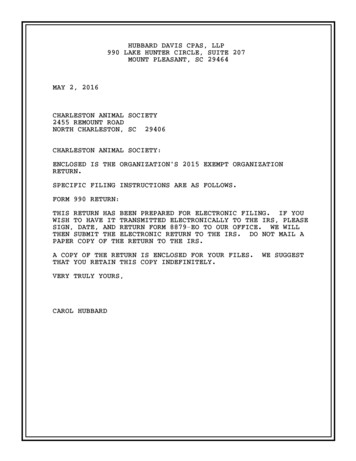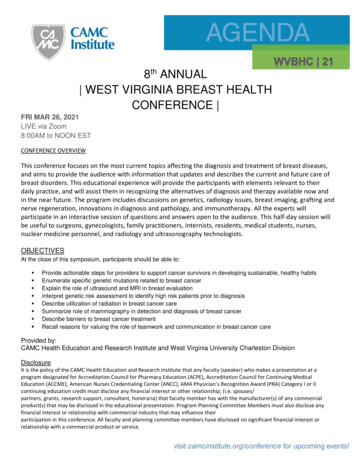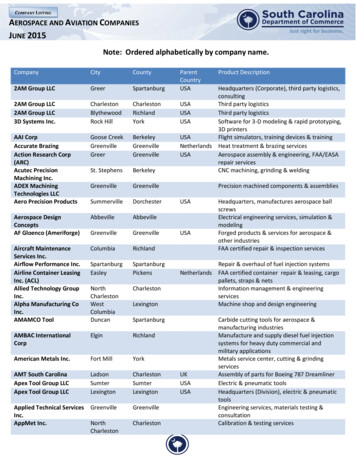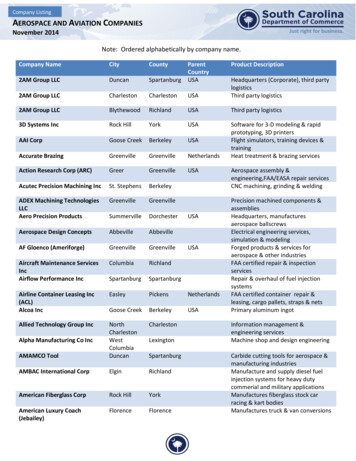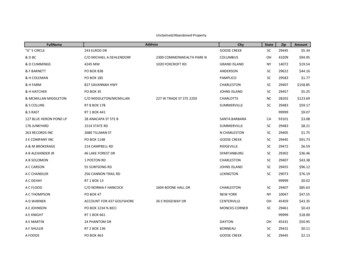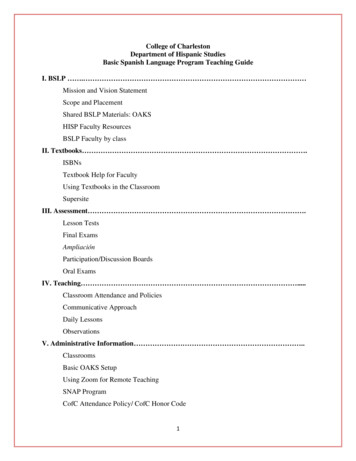
Transcription
College of CharlestonDepartment of Hispanic StudiesBasic Spanish Language Program Teaching GuideI. BSLP . Mission and Vision StatementScope and PlacementShared BSLP Materials: OAKSHISP Faculty ResourcesBSLP Faculty by classII. Textbooks .ISBNsTextbook Help for FacultyUsing Textbooks in the ClassroomSupersiteIII. Assessment .Lesson TestsFinal ExamsAmpliaciónParticipation/Discussion BoardsOral ExamsIV. Teaching .Classroom Attendance and PoliciesCommunicative ApproachDaily LessonsObservationsV. Administrative Information .ClassroomsBasic OAKS SetupUsing Zoom for Remote TeachingSNAP ProgramCofC Attendance Policy/ CofC Honor Code1
I. BASIC SPANISH LANGUAGE PROGRAMA. Mission and Vision Statement of the Department of Hispanic StudiesThe Department of Hispanic Studies offers students and the community a broad range of coursesand programs to develop language competence, a global perspective, and an understanding of theSpanish language, literatures and cultures of the Hispanic world. In addition, the Departmentseeks to promote the study of Portuguese at the college. Specifically, the Department aims to: Ensure that College of Charleston students acquire sufficient knowledge of the language tobuild proficiency in the language when future personal or professional needs require it.Prepare majors and minors for success as professionals in career fields related to Spanish.Teach understanding and appreciation of Hispanic and Luso-Brazilian cultures and provideknowledge about the literary and intellectual achievements of these worlds.Provide opportunities for study abroad in areas where Spanish and Portuguese are spoken.Enhance the education of students who are not Spanish majors by providing language skillsthat complement their chosen major.Lead with internationalizing the College of Charleston curriculum.Work with the School of Education to prepare Spanish language teachers bothsubstantively and pedagogically for the South Carolina school system.Provide opportunities for continuing study of Spanish at the graduate level for languageteachers and other professionals in the Charleston area.Promote articulation between secondary schools and the College in the teaching of Spanishand Portuguese.Provide service learning and internship opportunities for students of Spanish to use theirskills in the community.B. Scope and Placement.The BSLP includes 6 courses with overlapping scopes: SPAN 101, 102, 201, 190, 200, and 202.Students at the College of Charleston must complete through SPAN 202. In Hispanic Studies,incoming students are placed as follows:True beginners:Students with two or three years of Spanish:Students with four years of Spanish:Students with five years of Spanish:101-102-201-202190-200-2022022752
The courses cover the following chapters of Aventuras:101- Aventuras Chapters 1-4 (5e)190- Aventuras Chapters 1-7* (6e)102- Aventuras Chapters 5-8 (5e)200- Aventuras Chapters 7-12* (6e)201- Aventuras Chapters 11-14 (5e) 202- Aventuras (5e) Chapters 13-16 Starting in Spring 2022, SPAN 200 will cover chapters 8-12.If you notice that a student in your course seems to be at the wrong level or if a studentcomplains that he/she has been misplaced, email your recommendation for placement toHISP@cofc.edu and tell the student to meet with a departmental administrator or thedepartment chair as soon as possible. Changes MAY still be made within two weeks of theregular course drop/add date.Also, it is important for the health of our program to recruit good students in the lowerlevels. Please encourage strong students to continue in Spanish and to consider a minor ormajor. You could send them an email like this:Dear ,I wanted to reach out to you because you have such a natural ability with Spanish! I have taught many students, so trust mewhen I recognize your skills. I would like to encourage you to keep learning the language beyond the gen-ed requiredcourses. You show a great control of the skills taught so far and are also interested in the language and culture, so you shouldconsider a Spanish minor or major.A Spanish minor or major will complement any other major and will be a valuable skill to add to your resume. It is easy todeclare the minor or major: you can even do it online. The benefits to learning a language are endless!I would love to have this conversation with you if you want to talk after class one day or during office hours. I hope you willconsider this idea, because you would be a great addition to our Spanish program. Thanks for working hard this semester,and keep it up!Saludos,C. Departmental OAKS class/ Department websiteAll departmental materials are now being shared via the special OAKS Class Hispanic Studies.Click on View all courses on your OAKS home page to find it. All faculty are enrolled asContent Assistants, which allows full access. PLEASE remember to use this site to share youractivities and assessment instruments. Use your name as part of each file identification.Another good source of information is the website for the Department of Hispanic Studies,especially the Faculty Resources page.D. BSLP Faculty by Course for Fall 2021Spanish 101Daniela MeirelesJosé MoreiraCarola RamírezAllison ZaubiSpanish 102Marisol CastroSoledad FrancisEileen ShieldsAllison ZaubiSpanish 201Adelaida BidotJosé ChávarryYulián MartínezAllison Zaubi3
Spanish 190Adelaida BidotMarisol CastroDavid DulceanyChristina GarcíaLiana HakobyanBetsy HanceFenner HoellBerenice MarquinaCarola RamírezSpanish 200David DulceanyBetsy HanceFenner HoellTina MaricYulián MartínezCathy RodgersEileen ShieldsSpanish 202Adelaida BidotRaúl Carrillo ArciniegaElizabeth CoxDani DelgadoSusan DivineSoledad FrancisCarmen GraceDevon HanahanBetsy HanceTina MaricColleen MoormanClaudia MoranGeorgia SchlauRaúl Sojo-MontesII. TEXTBOOKS- AVAILABLE AT COLLEGE OF CHARLESTON BOOKSTORE.A. ISBNs for students purchasing online at www.vistahigherlearning.comPrices as of 6/1/2020Hardcover TextbookSupersite Plus Code(w/WebSAM vText)Looseleaf Textbookand Supersite PlusCode (w/WebSAM vText)Supersite Plus Code(w/WebSAM vText) ONLYavailable only atwww.vhlcentral.comAventuras, 5eISBN:978-1-68004-964-0 312.00ISBN: 978-1-68004-9725 264.00ISBN: 978-1-68004-952-7 185.00Aventuras, 6eISBN: 978-1-54333-866-9ISBN: 978-1-54333-615-3ISBN: 978-1-54333-616-0ATTENTION! If your students are placing into 202 as your first course in the Aventurastextbook, they have the option of purchasing the less expensive 6 month book eofcharleston.ISBN: 978-1-54330-327-8 (Includes 6 months of access to Supersite and vText- 115.00)B. Textbook Help for Faculty/ OAKS classUnder Content in the OAKS class you will find a PDF of the Instructor’s Guide to the Supersite.At the bottom of each page of the site you will see a link: support.vhlcentral.com that you canclick to submit a help request. The tech reps at Vista are very helpful and are accessible withoutgoing through a phone menu: 800-922-6003. Our sales representative is Shaun Thomas, and he4
can be reached at thomass@vistahigherlearning.com. The official campus support person isDevon Hanahan, at hanahand@cofc.edu.Click on these links for documents explaining to students how to get books/online accounts forour texts: VISTA\Getting an account for Aventuras.docx. All syllabi and any other sharedmaterials can be found in the Hispanic Studies OAKS class.C. Using the Textbooks in the ClassroomSyllabus- All BSLP instructors are required to keep up with the syllabus and cover the chaptersand prescribed material assigned to each level. The department serves more than 5,000 students ayear, and it is important that all students be prepared with the same content as their peers fromother classes.vText vs. Book-Students MUST be given the option of using their laptops and the vText ofAventuras. If students choose this option they must be held accountable for not accessing otherwebsites during class.vText in Class-It is a good idea for the instructor to start up the Supersite and have the vText onthe screen before class starts every day. This will provide quick access to text pages, links tovideos and listening sections, and homework activities about which the students might havequestions.Presenting Vocabulary- Each time they are about to start a new chapter, students have anassignment the prior night to open their vTexts to the first two pages of the chapter, click on thenew vocabulary (which is live), and repeat it out loud before doing one homework assignmentusing that new vocabulary. Please encourage students not to skip this important step. AlthoughPreparación is listed only on the first day of each lesson, it is understood that you will includevocabulary activities or incorporate new vocabulary into your lessons each day. The studentshave at least one vocabulary homework assignment each night.Presenting Grammar-Although the grammar is presented deductively, it may also be presentedinductively and in the target language during class. Remember also that the students have beenassigned a grammar tutorial with one practice activity the prior night, so they should at least befamiliar with the concept you are covering. If you choose to start a grammar topic on the firstday of class (usually dedicated to vocabulary), you may of course do so.Presenting Culture-Feel free to expand on cultural topics offered via the links provided (forexample, on the Cultura reading pages in Aventuras) or through your own resources.The Apuntesculturales that follow the telenovela in Facetas are short, but they provide good points ofdeparture for expanding the lesson. Remember that each cultural reading section of Aventurashas a supplementary reading selection accessible only online by clicking on5.
Videos-The videos assigned in Aventuras are an important part of each chapter because they givethe student an opportunity to see all of the elements of the lesson combined in real worldsituations. The resumen at the end of each one is equally important. The videos also appeal to thestudents because they are used to multimedia and because students gain a sense ofaccomplishment by watching and understanding the episodes. It is up to you to determinewhether the students watch the videos at home or during class, and this may vary by chapterdepending on how you plan to incorporate the videos into your lesson. If the students are towatch the videos at home, you can assign homework activities to ensure that the students actuallysee them. On your homepage go to Content Activities Aventuras. The same is true forFlash Cultura and even the very short realia bits in Videoclip. If you want to assign the wholevideo to watch at home, be sure to select the very first activity under the Aventuras list ofactivities. This is the only activity that shows the whole video and not just an excerpt.D. SupersiteRegistering- Students do not need a course code to register in your class, as they will find youby state, institution, and professor name. Once they buy their code they may use it at any levelfor 36 months. (Exception- those placing into 202 who might use the 6 month access code.)Make sure your students know that they need to register on the Supersite right away and thatthey need to take the time to look carefully at all of the sections and choose the right one.Contact the BSLP Coordinator if any students end up in the wrong section so the students can betransferred.Access- Often students complain that they do not have access to the Supersite although theybought the code. Most of the time this problem is caused by the fact that the student bought theSupersite Plus vText code without buying Supersite PlusvText PlusWebSAM. They can buy this 25 WebSAM add-on code and they will then have full access. They can visit the Store at VHLand use the ISBN code 978-1-68004-956-5 for the add-on code.Grace Periods- Some students need extra time before they are able to buy the text/online code.Encourage them to enroll in your class anyway and let them know that when they get to thescreen that asks for a code, they should just click Continue. When they appear on your roll, theywill have a red explanation point next to their names. Assign them a Grace Period under theRoster section of the Supersite dashboard. They will have access for two weeks. See theHispanic Studies OAKS site for specific instructions for students and instructors to activate thegrace period.Homework- Each class will have its homework assignments uploaded before the semester starts.Homework is 90% of the grade, Tutorials are 5%, and Practice Tests are 5%. There is also anExtra Practice/Test category worth 0% that you can use at your discretion. You can make somechanges in your own sections if you need to modify a due date, add activities, and delete or6
change activities. Students are automatically assessed a 20% late penalty each day for latehomework and a 20% late penalty each day for late tutorials.The Practice Tests are graded on a Credit/No credit basis, but they do show the students an actualgrade out of 100%. It is important to be familiar with your students’ forthcoming activities andthe results.You can add instructor notes to any activity by opening the activity and clicking on Instructor’sNote. This can save a lot of questions and headaches if the activity has any tricky parts. If youwant to review a student’s individual work or change the grade of an activity, click on the gradeitself. If you want to accept late work from the whole class or give the whole class a 100% on anactivity, click on the name of the activity at the top of the column of grades. The Instructor’sGuide to the Supersite explains these and all other options thoroughly.Be sure that students know that each activity includes a link at the bottom saying “Ask yourinstructor”. They may click on this to send questions directly to you about an assignment.Instructor Graded Homework- Each chapter has been assigned at least one instructor gradedactivity in an effort to improve students’ writing skills. You may grade each student individuallyor you may choose the QuickGrade option, where the computer randomly selects severalstudents to grade and assigns 100% to all other students who did the work.Number of Attempts for HW Activities- The default setting for the homework assignmentsgives the students as many attempts as they prefer; however, for assignments asking the studentto choose one of two options and for open ended writing assignments, the students receive onlyone chance. They should plan accordingly.Order of Homework Assignments- It is important for the students to do their homework inthe order found on their syllabus, because just as in the classroom, the homework follows apattern of Review- Learn- Practice. Students will review and practice what they worked onin class that day, then they will watch a tutorial on the next day’s topic, and finally theywill do one very simple homework assignment based on that tutorial to hold themaccountable.Extra Practice for Students- Due to the volume of activities on the Supersite, not all areassigned. Students wanting extra practice can go to Content Activities and select what theyprefer. Under Content Vocabulario they will find electronic flashcards, and with Content Repaso they will find practice tests and activities that review several chapters at a time. Theymay also resubmit activities on a practice basis by clicking the Practice button at the bottom ofeach activity. There is an EXTRA PRACTICE grade category worth 0% if you would like toassign extra/optional practice to the whole class.7
Supersite Grades- It is important for students to track their progress and for instructors to beaware of their students’ progress with the homework. Your OAKS gradebook should include ahomework grade for each chapter to be entered when chapter test grades are entered. TheSupersite now calculates the chapter grade, including all categories, without running a report.However, you may still run reports to check on how much time students are spending on the siteand other information.III. ASSESSMENTA. Test SecurityOnce you review tests and exams with your students, you must collect and keep them inyour office. Do NOT allow students to take home tests or have unsupervised access to them.Tests and final exams must be stored for TWO years before disposing of them.B. Lesson TestsThe Supersite offers several versions of tests for each chapter that you can adapt as you like. Besure that every test includes: Listening.Writing.Contextualized vocabulary sections.Contextualized grammar sections.Culture questions.Reading, especially in 202.If the Supersite offers a testing section that is NOT contextualized, please adapt it beforeadministering it. For example:Section offered by Supersite:Adaptation:El verbo ser: Fill in the blanks with the La clase de español. Complete the paragraphappropriate present tense forms of the verb with the appropriate present tense forms ofSER.SER to tell about Ana’s Spanish class. (5)1. Emilio y yoMe llamo Ana, y yo estudianteen la clase de la Sra. Ruiz. Ella miprofesora favorita. Los otros estudiantesinteligentes, y nosotroslos estudiantes favoritos dela profesora. Y tú, ¿estudiante de español también?2. yo3. tú4. mi profesor8
5. ustedesIn the OAKS class you can find at least two tests for each level (101-202) posted. You can usethese or adapt them as you prefer. Faculty members are encouraged to collaborate on tests andshare their materials, which is easy to do on OAKS. You may also see the BSLP Coordinator forhelp or feedback writing tests.C. Final ExamsWe do not have departmental final exams, but all BSLP faculty are required to administercumulative final exams on the day and time that has been assigned to each class. Faculty mayshare their exams with each other. Exams must follow the same guidelines as lesson tests. 102and 202 exams must incorporate the GenEd Assessment into their exams without altering it inany way. The GenEd Assessment Instrument includes reading, writing, and listening activities. Apractice instrument will be sent out for 202 instructors to use before the final exam day, and theinstrument itself along with detailed instructions will be distributed well before exam week.D. AmpliaciónEach chapter in Aventuras includes the Ampliación assessment. You may administer thisseparately from your lesson test OR you may eliminate it and substitute short formativeassessments culminating in a task-based test. The Ampliación grades will go under the Quizzes/speaking/writing grade category. These rubrics are fairly general and may be edited as you prefer. In one chapter you might wantto do all three elements (Escuchar, Conversar, Escribir) and in another you may want to doonly one or two and add Un paso más or Lectura. Just be sure to include some listening andwriting throughout the semester. You can also edit the writing page to your preference You may want students to write in or out ofclass, depending on class time constraints. Although a pre-writing prompt has been included foreach assessment, there is no space for a revised paragraph. You are welcome to implement thepeer-revision element and request multiple copies. Again, each chapter does not have to beapproached in exactly the same way. You will notice that the Conversar rubric relies heavily on self-grading. Naturally you willcirculate while students are speaking and you will note lapses into English, etc., and you willhave the option of altering their grades. But research shows that students tend to be brutallyhonest when self-grading. The point of this Ampliación section is to have students speak withconfidence, some sense of control, and a willingness to explore their language capabilities.9
Each chapter of Aventuras includes several Partner Chat and Virtual Chat assignments that can beused in place of the Conversar section of Ampliación. Instructors may also choose to create anduploads their own Partner Chat assignments. These may all be graded individually or via theQuickGrade system. Consult the Supersite Instructors’ Guide or the BSLP Coordinator for helpwith this option. The Escuchar sections have the script in blue on the right side of the page, but you can also clickon the emblem right on the page on the v-text to have them listen to a tape. If there is a section of Ampliación that you would like to replace with something of your own, goahead! Often instructors implement an unassigned listening activity from the homework or testingsections or a different writing prompt.E. Quizzes/Flipgrids/Partner Chats/ etc.Each course includes a grade category that gives you flexibility on shorter assessments. You may enterquizzes, partner chats, flipgrid assignments, short projects, etc.: whatever it is you do to assess studentsoutside of the assigned chapter long assessment.F. ParticipationAs a communicative based program, it is important to assess and reward participation,remembering that meaningful production is more important than accuracy. There are severalfaculty produced participation rubrics available on OAKS or you may use one of your own, aslong as you are consistent with your approach. Spanish 202 students also have the opportunity toparticipate in a cultural discussion board outside of class. You may choose to set this up for otherlevels as well.IV. TEACHINGA. Classroom Attendance and PoliciesInstructors may not cancel class except in cases of emergency, at which time the DepartmentChair, BSLP Coordinator, and both departmental administrative assistants should be notifiedimmediately via email. If you know that you are going to miss a class well in advance, pleaseclear this with the Department Chair or BSLP Coordinator and find someone to cover yourclasses.All instructors are expected to start class on time, teach the full time, and end on time sothat students are not late to their next classes.Students are expected to arrive on time and stay the whole period without leaving class.Please enforce this policy.10
B. Communicative Approach- Our department is dedicated to the ideals behind thecommunicative approach to language learning, which can be summarized as including: An emphasis on learning to communicate through interaction in the targetlanguage.The introduction of authentic texts into the learning situation.The provision of opportunities for learners to focus, not only on language but alsoon the learning process itself.An enhancement of the learner’s own personal experiences as importantcontributing elements to classroom learning.An attempt to link classroom language learning with language activities outsidethe classroom. An emphasis on learning to communicate through interaction in the target language:Even in Spanish 101, the class can be entirely conducted in the target language. The instructormust speak more slowly and clearly, must use simple expressions and as many cognates aspossible, must repeat often, act out or circumlocute unfamiliar words, and focus on activevocabulary. It is much more difficult to conduct the class entirely in Spanish, and it eliminatessome interesting anecdotes and areas of study that might be beyond the students’ comprehension,but it is worth the effort.The introduction of authentic texts into the learning situation:The textbook in the BSL Program includes realia in the form of literature, videos, ads, and artwork. Instructors are encouraged to enhance their own lessons with their own input of authentictexts and work.The provision of opportunities for learners to focus, not only on language but also on thelearning process itself:Students need to know that they are at a level in which they are expected to make frequent errors,especially in speaking, and that the path to improving their skills lies in overcoming their fear ofmaking these mistakes. By focusing on meaningful production and encouraging communication,no matter how faulty, we can remove that fear. Also, the more that students understand why wedo what we do (i.e., repeating vocabulary aloud, demanding complete sentence answers, etc.),the more engaged and interested they will be in their own success. Instructors can post theNSSFL- ACTFL Can Do Statements on their OAKS pages and can encourage students to befamiliar with them and plot their progress on the scale.An enhancement of the learner’s own personal experiences as important contributingelements to classroom learning:11
Meaningful communication means that the information exchanged is about the students, asopposed to information exchanged only to manipulate new grammar forms or vocabulary. Themore we can relate our lessons to students’ personal lives, the more engaged and successful theywill be. The learning brain does not separate emotion from cognition, and when there is apersonal relationship between the instructor and the students, learning is optimized.An attempt to link classroom language learning with language activities outside theclassroom:Students need to be reminded constantly what the real prize is at the end of the semester: not thegrade or the credit, but the ability to communicate with others in Spanish. With the globaleconomy and with 1 in 6 residents of the US being Hispanic, the need for Hispanic Languageand cultural proficiency is greater than ever. (See http://scspanishteacheroftheyear.org/about/)Part of our responsibility is to keep that prize clearly in their sights by reminding them of studyabroad opportunities and extracurricular activities, some of which can be seen here:-Spanish Club ar/spanish-club.php)Hispanic Latino Club ar/hispanic-latino-club.php)Portuguese Club tivities/)Casa Hispana (http://casa.cofc.edu/)Sigma Delta Pi (National Collegiate Hispanic Honor Society) r/sigma-delta-pi.php)Tertulia bal Scholars ished Speaker Series (http://spanish.cofc.edu/)-Study Abroad s/studyabroad.php)C. Daily LessonsLesson plans- Although the syllabus provides information on the material to be covered, it doesnot offer an actual lesson plan. If you are new to teaching and would like help composing lessonplans, please consult with the BSLP Coordinator. As a rule, you should have a meaningful,observable communicative goal for each class:Today in class my students will learn the regular preterit and will practice their new vocabulary.(Not observable and too general.)vs.Today in class my students will orally describe their leisure activities from last weekend to apartner using their new vocabulary and the regular preterit tense. They will write a summary of12
their partner’s activities to be submitted to the instructor. (Observable, meaningful, andspecific.)Daily pattern- In general a class should follow the pattern of Review, Learn, Practice: Studentsshould review previous information, learn new information that relates to and builds on thereviewed material, and then practice the new material. Every effort should be made to transitionlogically between each segment of the lesson so students do not feel like they are just rollingthrough a random list of information.Balance- It is important to engage all four modalities of learning--reading, writing, listening,speaking-- each day. It is also important to balance time spent working individually, withpartners, and as a group.D. ObservationsNew professors will be observed by the BSLP Coordinator, the Department Chair, and theAssociate Chair throughout the year. Returning adjuncts and instructors will be observedperiodically or by request. Those professors scheduled for observation will be contactedaccordingly during the semester in question, but the specific days of observation will not beannounced.V. ADMINISTRATIVE INFORMATIONA. ClassroomsMost classrooms controlled via access codes, keys, and swipe cards. In order to find out whetherentrance to your classrooms is restricted, follow the steps below: Logon to “My Charleston”Click the “Faculty” tabAt the bottom of the page, in the center column, there is a box titled “Faculty QuickLinks” click on “Classroom Access Codes”.If a classroom requires an access code, it will be listed here (Codes change fromsemester to semester). If a classroom requires a key or a swipe card, and it is in LONG,ECTR, or TATE, check with Laura Moses to see if the department has a key or swipecard that you can sign out for the semester. If not, call Classroom Support (TheHelpdesk) for help navigating the next step: 953-3375.B. OAKS13
OAKS is our course management system and is essentially a form of D2L (Desire 2 Learn). TheLCWA Liaison to Information Technology is Mike Overholt (overholtm@cofc.edu), and heoffers many OAKS training sessions online.We also house all syllabi, shared activities, tests, and other materials in our departmental OAKSpage- Hispanic Studies.Uploading your syllabus To upload your syllabus to OAKS, please follow the steps below:Click on “Content” (at top)Click on “Add a Module”Create name (e.g., Syllabus, Programa del curso, etc.), and click.You can drag the document itself onto the module page or Click on “New”Click on “Upload files”Communicating with your class Click on Communication.Go to Classlist.On the upper left, click the empty box to the left of the email icon and then click theemail icon.If you would like to communicate with your students before the official start date of thesemester, go to My Home OAKS Requests (upper right) Request to Change CourseStart or End Dates.Se
I. BASIC SPANISH LANGUAGE PROGRAM . Spanish language, literatures and cultures of the Hispanic world. In addition, the Department seeks to promote the study of Portuguese at the college. Specifically, the Department aims to: . Under Content in the OAKS class you will find a
